Dec 23, 2004
The cold weather's gone, for the time being. On Monday I drove with my friend Lonnie to his country house upstate New York. Bad news - it was so cold that the oil for his furnace had gelled and there was no heat to be had. So up we went to light some fires in the wood stoves to keep the pipes from bursting.
Man, was it cold! Lonnie's hi-tech digital indoor/outdoor thermometer read 1.3°. Even after three hours of roaring fires in his two wood stoves the house temperature could only be brought to 59°. I cooked up some pork chops and made a salad and we had a nice dinner huddled in the kitchen keeping close to the wood burner. And when we turned in it felt like I was sleeping in a walk-in freezer in one of the upstairs bedrooms. No matter, a few blankets piled on and my body heat warmed up the bed after a few minutes. Needless to say, the furnace repairman came about 3am (it must have been a busy night for him) but still couldn't get it fixed. Apparently, and this I learned from Google, most homes use Heating Oil #2, a thick, gooey fuel that can gel and freeze-up as the temps get very low. In those climes where sub-zero temp is a regular occurrence one must add Kerosene (aka Heating Oil #1). This is a more-refined fuel and prevents the gelling that occurrs. Too late now though.
The next day brought another repairman. But it also brought warmer temperatures. The combination produced nice warm heat for Lonnie's house. But it was back to the city for me while Lonnie stayed to keep an eye on things.
Yes the cold was gone and downright warmth had returned to Brooklyn. Enough to go exploring on my bike again. With temps in the 50's it was a beautiful Wednesday and I rode around carrying out some errands to the bank and post office. Then I decided I would visit the Brooklyn Central Library. It was years since I had a library card and I wanted one because this beautiful building and the immense collection it houses are only a few blocks away beckoning.
It was late already and the solstice sun was getting ready to call it quits for the day as I rode up to the library. What a magnificent building. But it, according to the Central Libary History, a sheet I picked up inside, was a long time in coming.
Take a look at these dates:
• In 1889 the Brooklyn Park Commission was authorized to select a site for the Central Library.
• In 1905 the choice of the triangular plot at Prospect Park Plaza (now known as Grand Army Plaza)was adopted by the legislature.
• In 1912 ground was broken for architect Raymond F. Almirall's Beaux-Arts building
• From 1915 to 1927 construction slowed down and then halted for WWI and the Great Depression.
• In 1935 new architects, Alfred Morton Githens and Francis Keally were selected for a new design that would be more modern and would cut costs.
• In 1937 plans were approved for a $1.88 million dollar structure.
• In 1938 construction began and in 1941 regular service commenced.
Wow! A long time to build a beautiful public library. And the story doesn't end. Over the years, there were additions and renovations and terrible budget cuts (more to come in the era of Bloomberg/Bush). But the library stands and serves the community as a focal point of public information and education.
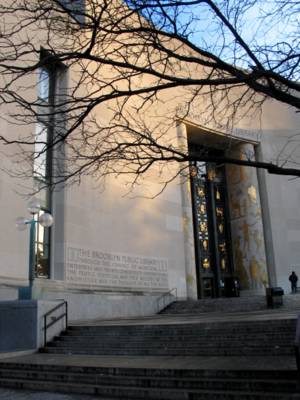
Steps leading from Eastern Parkway up to the main entrance of the Central Library.
I didn't realize it but the building is shaped like an open book. It's clad in limestone and has beautiful Art Deco detailing around the 50-foot high entry portico.

The dramatic entrance to the Central Library has columns on both sides with gold-leaf figures depicting the evolution of art and science. The panels on the bronze screen above the doors are sculpted by Thomas Hudson Jones with favorite characters in American writing, including Tom Sawyer, the Raven and Moby Dick.
Well getting a library card was a harmless 3-minute task and then I set about to figure how the library was organized. Being a member of the male genus, I refused to ask for help but did pick up some sheets on using the catalog system. The library has dozens of terminals for conducting searches which I tried. Then I decided to browse some of the reading rooms. I ended up with the following:
• A book on how to write poetry.
• An anthology of Poetry classics from the last 200 years.
• A how-to write your own greeting cards, bumperstickers, t-shirts.
• A history of the assassination of Lincoln.
• "How The Irish Saved Civilization."
These have to be back by january 10th (or you can renew on line now!)
I haven't been a reader all these many years. Mostly periodicals and a very occasional book. I'm not proud of that. Perhaps I can use retirement to catch up and make ammends. Stacey is sceptical. Time will tell.

When I left the library after an hour or so, this was the sight that greeted me - the fabulous arch at Grand Army Plaza, Park Slope in the backgroud and an impossible blue sky with fading sunset.
Dec 16, 2004
Yep, my jury duty is in recess until January 5th. Don't ask. Can't tell anyway. So it's back to my usual routine. I've been observing Atlantic Avenue which fascinates me. It's a historic main thoroughfare that runs east from New York harbor out to the middle of Queens, running out of steam at the Van Wyck Expressway. It has some of the heaviest traffic in Brooklyn and most of the way it is gritty and depressed with light industry, storefronts, small, dilapidated apartment houses and the like.
On its western end, however, it divides two lovely neighborhoods: perhaps Brooklyn's most upscale brownstone community, Brooklyn Heights, to its north and to its south, Cobble Hill. Here, from Flatbush Avenue west to the harbor, there have long been signs of gentrification and renewal. It's been proceeding slowly for a long time but it seems to be on a roll now with new luxury high rises being built and the propsed basketball stadium which, if RATner gets his way, is to rise above the Long Island Railroad tracks. Ominous signs of the Manhattanization (read "towering high-rises") of the downtown area are everywhere. What a shame that these neighborhoods, which are like precious jewels along the rim of Brooklyn are being targeted by the big money developers. As people flee the unaffordable rents in Manhattan, they cross the river and look to the very appealing and less frenetic, low-rise neighborhoods that are within a few subway stops. Of course, the rules of capital apply here too and rents and property values are zooming through the stratosphere in Brooklyn as well.
As I biked up Atlantic Avenue, it seemed a microcosm of the old Brooklyn and the new new high-rise Brooklyn that the developers have in mind. Battles are raging as many want to preserve these neighborhoods and the charming 19th century feel that they are imbued with.
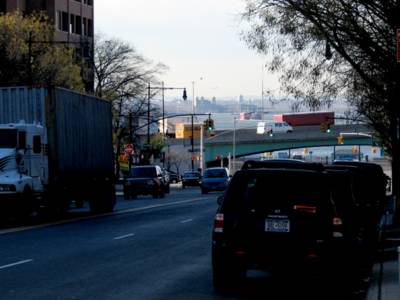 Atlantic Avenue originates at the harbor and runs out to Nassau County.
Atlantic Avenue originates at the harbor and runs out to Nassau County.
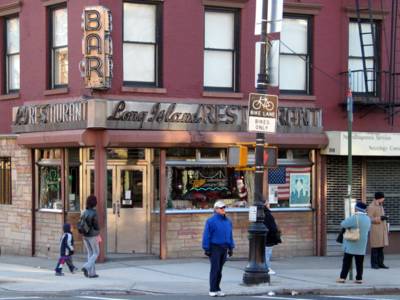 On the corner of Atlantic and Henry is this old bar with a great neon sign.
On the corner of Atlantic and Henry is this old bar with a great neon sign.
 The "old" Atlantic Avenue - charming old buildings, antique stores, restaurants. Will this remain or be gobbled up for development and 20 story (and up) buildings?
The "old" Atlantic Avenue - charming old buildings, antique stores, restaurants. Will this remain or be gobbled up for development and 20 story (and up) buildings?
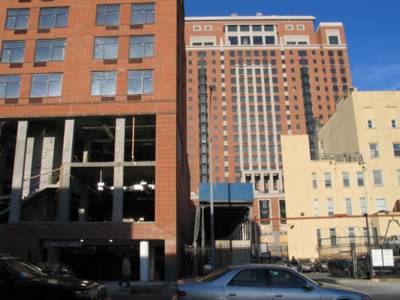 The "new" Atlantic Avenue. Here a municipal parking lot on the corner of Court and Atlantic is being replaced by a humongous luxury building called "The Courthouse." It takes up almost an entire city block. Behind it, on the right, another huge building on State Street. Congestion - here you come! Arrrgghh!
The "new" Atlantic Avenue. Here a municipal parking lot on the corner of Court and Atlantic is being replaced by a humongous luxury building called "The Courthouse." It takes up almost an entire city block. Behind it, on the right, another huge building on State Street. Congestion - here you come! Arrrgghh!
 One of the earlier conversions...this condo apartment house was originally the factory where Ex Lax was made (see lettering on door). No comments please.
One of the earlier conversions...this condo apartment house was originally the factory where Ex Lax was made (see lettering on door). No comments please.
 An intersting, copper-clad building on Atlantic near 3rd Avenue.
An intersting, copper-clad building on Atlantic near 3rd Avenue.
 The Williamsburgh bank building (now HSBC). This is the tallest building in Brooklyn and stands at the corner of Hanson Place and Flatbush Avenue (just a smidge north of Atlantic). In the foreground, the Brooklyn YWCA at 3rd Avenue.
The Williamsburgh bank building (now HSBC). This is the tallest building in Brooklyn and stands at the corner of Hanson Place and Flatbush Avenue (just a smidge north of Atlantic). In the foreground, the Brooklyn YWCA at 3rd Avenue.
Dec 10, 2004
I'm unable to write as I've been selected for jury duty and will be serving for the next week (or so). Maybe I'll write my experiences of "Life On The 10th Floor" of The Central Courts Building at 120 Schermerhorn Street in Brooklyn (home of Criminal and Supreme Courts)but not till it's over as per the judge's admonitions. Till then.
-Matt

Me - Blogging at home after a day in the jury box.

The Central Courts Building at 120 Schermerhorn Street in Brooklyn - home of Criminal and Supreme Courts.
Dec 6, 2004
I've been running around and been mighty busy and been thinking of my Blog - yet unable to find the time to indite. And so, herewith, a brief review of the week in pictures. Pictures are the primary reason I Blog in any case - my writing is subsidiary to my photography which I enjoy and which skill I want to develop (not a pun).
Tuesday night, the second, I attended a meeting of Brooklyn Parents For Peace. They are a local peace and justice organization and have a strong presence in the community.
I met my friends Henry Foner and Bobby Greenberg there and we were to meet the full-timers from the Barbaro campaign for a dinner/reunion. I organized this reunion because I wanted to keep in touch with these new friends who I had come to admire so much.
The meeting was impressive. About a hundred local activists, members and others, new and old to the peace movement gathered at the YWCA on 3rd Avenue to plan the way forward (in the light of the election results). It was a heartening turnout which suggested that people are not throwing up their hands in dejection and are preparing to intensify the fight against the Bush policies over the next few years. Congressman Major Owens spoke (from the audience) and, amazingly, stayed for the rest of the meetng. So many times I've seen politicians come in, speak and leave. Not so with Owens and that made a big impression on me. He spoke of how people were suffering in his district and made a plea to the peace movement to focus and address those issues.
The full-timers, Liz, Ray and Mike, showed up and the five of us left the meeting early. We drove to Cafe Luluc for dinner, just a few blocks away. The chemistry was just right despite the age span. Liz had just turned 21 and Henry is 85. We had a blast (the wine helped, no doubt) and we talked the night away, recalling some of the high points of the campaign and talking of the future. It was a great evening.
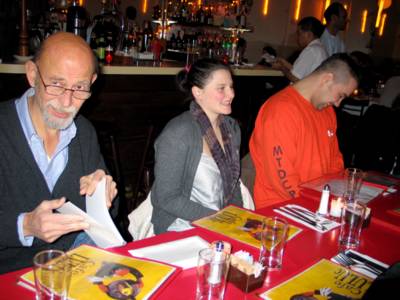
Ray, Liz and Mike perusing the menus at Cafe Luluc.

Bobby and Henry and some of the wine they enjoyed.

Me and my friend, Henry Foner.

All of us, after dinner.
.....
Our friends, "The Beans," visited us for the weekend. The "Beans" are Ellen and Brian, who've been our friends for close to 40 years. Actually, Stacey and Ellen go back to childhood because their parents were best friends when both couples lived in Flatbush in the 50's.
Ellen and Brian live in Arlington, VA and often come to New York. Likewise, we travel to Washington and visit them. This was their first trip to our new apartment. We had a lovely weekend - just doing New York things.
We picked them up at Penn Station and drove back to Brooklyn with a stop at Sahadi's , a wonderful mid-eastern gourmet grocery on Atlantic Avenue in the heart of Brooklyn's Arab community.

Sahadi's grocery on Atlantic Avenue - for wonderful mid-eastern and gourmet delicacies.

Brian and Ellen amidst the olive oils at Sahadi's.

My friend Brian.
Later Friday we took the subway to Lincoln Center for theater to see The Rivals at Lincoln Center. Written in 1775 by Richard Brinsley Sheridan, whose most famous play was School For Scandals. Despite its age, it's a witty little farce that stands up to modern sensibilities.

Late day winter light from Underhill Avenue looking east.

Taking the subway to Lincoln Center for theater.
The next day, Saturday, was spent walking Manhattan. It was a gorgeous fall day with a brilliant blue sky, holiday crowds out on the streets. Union Square was our first stop. Not only the usual Saturday Greenmarket but the annual crafts market was open for business. A great place to shop for gifts.

Potatoes at the Greenmarket in Union Square.
From Union Square we walked up Broadway toward Grand Central Station for a look around at the holiday laser show and the Transit Museum' (they have an annex there) model train exhibit. Tuckered out, we took the Shuttle and the Q back to Brooklyn for dinner and a night at home relaxing.

Walking uptown: the Flatiron building in that glorious late day light.

NY Life peeks through buildings on East 22nd Street.

Walking up 42nd street for a view of the wondrously sunlit Chysler building.
......
Sunday was another beautiful day (weather-wise) and we headed to the Brooklyn Museum for a look at the Marilyn Monroe photo exhibit: I wanna be loved by you.

Stacey and Brian in the lobby of the Brooklyn Museum.

Hamming it up at the museum.

Ellen examines the museum's new facade.
From the museum we walked over to the park and took a long walk through Long Meadow and over to the Nethermead. We ventured into the Boat House which now houses a branch of the Audubon Society. It had been renovated to its original condition and from upstairs we had a view of the water and surrounding trees - beautiful.
The days are short and walking back home our long shadows preceded us by many yards. It felt like we had walked the entire city but it was a good tired. We drove our friends back to Penn Station...they headed back to Arlington. We to Brooklyn.

Long shadows while walking in Prospect Park.
Nov 30, 2004
A lovely fall morning greeted me as I steered my bike into the entrance of Prospect Park. A few joggers and walkers were out doing their thing and I whistled by them, wanting to circumnavigate the park for my morning exercise. I sped down the hill toward the lake, my bike building up speed. The park is situated of top of the moraine that was formed in the last ice age (you remember that, don't you?) In fact, all of this area is up on high: Park Slope, my neighborhood of Prospect Heights, Eastern Parkway. That accounts for some fabulous views of Manhattan, looking north over the rest of Brooklyn and the East River.
When I reached the lake I stopped to admire the birds floating in the morning calm. There must have been a thousand ducks, geese, swans and other aquatic Aves. It was a beautiful sight - the morning light, a blue sky and the mirrored surface of the lake.

The lake in Prospect Park.

This little white duck in the middle thought he knew me and swam right up to me. He must have been mistooken or maybe he was just looking for a handout.
Continuing my ride, I took a middle road that led me into the center of the park. I rolled along alone as I crossed a little bridge that led me over the serpentine creek that feeds the lake. It flows through tall grasses and skirts a breathtaking meadow called the Nethermead and I remembered that, in another part of my life, Stacey and I would spend hours here with friends and our dogs. The dogs would run and play and we would sit and chat and take in the view and wile away the day. Now I was rediscovering and remembering the park once again that I had loved so dearly thirty years ago.
I returned, via the ring road, to the the top of the park and Grand Army Plaza. You'll remember from my last Blog the name of James Stranahan, the wealthy real estate developer and civic leader who was instrumental in the building of the park. Now, looking more closely at a statue in the entrance of the park I saw that it was Stranahan's likeness. The plaque describing him was badly weathered but I was able to understand that it attributed the building of the park to his efforts.

Looking up at James Stranahan.
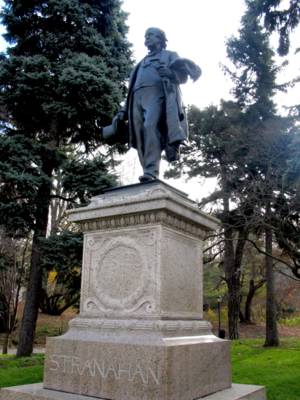
The man behind the park and its first commissioner, James ST Stranahan (What's with the "ST"??)
I was also impressed by the wall that separates the park from the street and the magnificent plaza beyond. Atop the wall are magnificent bronze bowls, each decorated with snakes whose tails entwine to form handles. What artwork for the public to admire!

The serpent-decorated bowls at the Grand Army Plaza entrance to the Prospect Park.
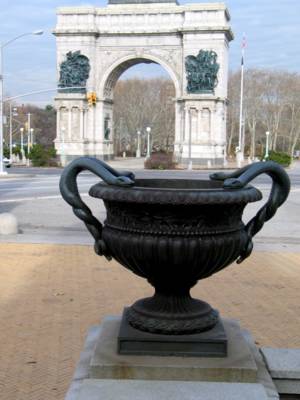
Another view of the bronze bowls mounted on the wall at Grand Army Plaza.

Who created these bowls? I haven't been able to discover the artist or any other mention of these magnificent pieces ... yet. Stay tuned.
My ride was over - just about 6 miles or so. Nice bit of exercise and some more reminiscing and appreciating this 526 acre masterpiece that belongs to the people of Brooklyn.
Nov 23, 2004
... Started out to the bank today. It's on the southern end of Prospect Park. I live on the north end. I took my bike and rode down there. It's just a few miles.
This park is too beautiful for words. It's a haven - a sanctuary - from the surrouding city and its hectic pace. Here, things move at Nature's pace. There's peace. And quiet. The designers of this park, Frederick Law Olmstead and Calvert Vaux aspired to that: peace and quiet. The city was rapidly expanding in the 1860's and the park was created to serve that rapidly growing population. Beginning in 1858, the two same genetlemen had created 800-acre Central Park. It was the very first landscaped park in the United States.
Brooklyn was developing at the same time as people left crowded Manhattan for the "suburbs." A local businessman and real estate developer, James Stranahan, wanting to attract wealthy people to Brooklyn, urged the creation of a Central Park in Brooklyn. He became the first president of the Prospect Park Commission and hired the design team of Olmstead and Vaux based on the plan they submitted in 1866.
Frederick Law Olmstead was not only a great landscape architect. He was also, in essence, a social activist. His vision of a city park was a place of tranquility and quietude where people could escape the frenetic clip of city life. He had a much broader and more democratic view of society than the Stranahans of his day and felt that these grand parks should belong to all the people not just the wealthy class but especially Brooklyn's poor who could find a bit of the countryside right in their own neighborhood.
Indeed. Autumn in Prospect Park is as glorious as any ride one can take upstate to see the changing colors of the foliage. It has pastoral meadows, undulating hills, exotic trees and plants of so many varieties, eagles, hawks, geese, swans and ducks. Lakes, streams, ravines and so much more. And today it is truly a people's park as Olmstead and Vaux envisioned it so many years ago.
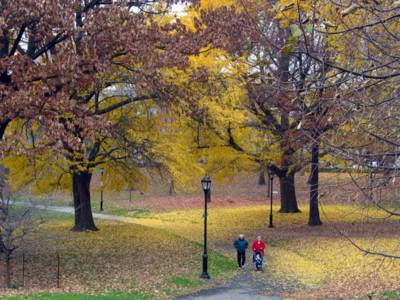 If you live in New York City, you can walk down
If you live in New York City, you can walk down
your sidewalk or you can walk HERE!
To live near the park is to be blessed. A three block ride on my bike and I'm there, coasting on its carriage roads - free from automobiles most of the time (and if Transportation Alternatives and other advocacy organizations have their way, it'll be car free all the time).
Today, it was so quiet I could hear the leaves softly falling and floating to the ground. Tap, tap, tap -- as each leaf softly landed on top of thousands of others that had already landed. I stopped and listened and just sighed.
I could also stop and admire a parade of Canada geese as their leader left the pond for shore and was followed, one by one by hundreds. It was as if they were flying in formation. But here they were waddling out of the water and across the path to peck for food in the grass. What a sight! The leader eyed me with curiosity and a little caution before he continued his pilgrimage.

This guy on the right was leading hundreds of Canadian Honkers on a parade from pond to lawn in search of food.

Two by two, up out of the water and onto shore, playing follow the leader. This went on until the lake seemed to be cleared of a hundred or so geese on some sort of pilgrimage.
This is also a park that is entwined with the history of our borough, city and country. Riding around the park roads I came across a statue of ---
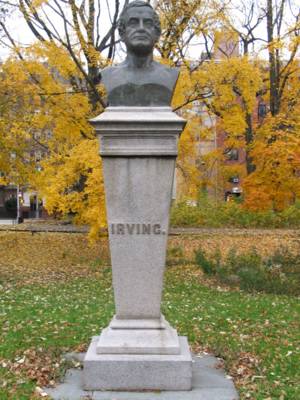
Irving. Mind you this is not just "Irving" but Irving, period!
A little Googling tells me that this is J. Wilson McDonald's representation of American author Washington Irving (1871). I guessed it was him. The statue sits across the carriage road from the Concert Grove.
Still further along is a plaque commemorating Battle Pass. Part of the Battle Of Brooklyn transpired here. That fight was the first of the Revolutionary War and the largest in terms of casualties. The British won that one but went on to lose the war.

A plaque commemorating Battle Pass where the Battle Of Brooklyn was fought.
Biking along brings me more astounding views of the fleeting foliage. I'm back at the top of the park now, where I started an hour before. I've been through this park many times before but now that I'm living nearby it seems new all over again. I'm looking forward to exploring it in depth and discovering its hidden secrets and treasures. I've fallen in love with Prospect Park.

Many trees have given up their leaves by late November. This one is still ablaze.

Standing here, quietly, I could hear the leaves hit the ground as they floated to earth.
Nov 21, 2004
Well Election Day came and went but the battle continues. While we were defeated (or as many feel - while the election was stolen once again - and the evidence is mounting daily that, indeed, it was) and are in a much worse position for advancing the people's struggle, nevertheless the battle continues...now on a different playing field with different tactics than we used during the election.
I participated, as readers of this journal well know, in a very exciting campaign. Frank Barbaro, a long-time friend and a life-long fighter for the people's needs, ran a strong and principled campaign in Staten Island and Brooklyn's 13th CD. The aim - to unseat one of the more right-wing members of Congress, Vito Fossella. Frank ended up with 42% of the vote - not a poor showing by any means. Two years ago the Democratic challenger didn't even reach 30% against Fossella. Frank ran on a solid progressive agenda and came close to winning. Message to the Democratic Party: you better look at the significance of Frank Barbaro's campaign. Frank did not move to the right as is the mantra of many of those in the Democrats. He stood and fought the good fight and people responded. We won in Brooklyn but lost in Staten Island, particularly the more conservative south shore. But even there inroads were made.
When people scratch their heads and wonder how working people can vote for the likes of a George Bush whose polices are so inimical to their self-interests they should look to the Barbaro campaign for answers. Speak to people's interests with plain talk and without prevarication and shifting positions based on the latest polls and the handlers (fancy, high-paid campaign managers) mandates. Frank was a very clear cut alternative to the right wing, anti-labor policies and activites of Fossella and he made it known. For that he received 42% of the vote on a campaign that had a tiny fraction of the resources and money of the incumbent.
We had a volunteers thank you party at the home of Joy Whelan on Friday night. It was a wonderful affair. Joy's house was packed with some of the many, many people who participated in the campaign. Henry Foner sang the Barbaro campaign song (that he composed). Eddie Kay and Frank and others addressed the crowd. Food and drink was plentiful. Frank pledged to continue fighting the good fight and not to allow the base that had been built from this campaign to dissolve. Onwards!
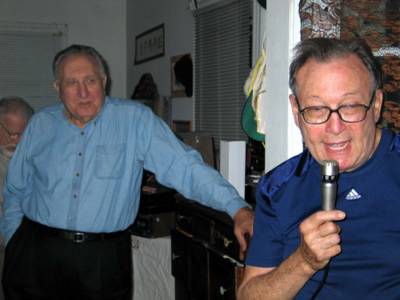
Henry Foner gives a rousing performance of the Barbaro campaign song that he composed.

Eddie Kay introduces Frank.

Frank says thanks to the volunteers.

A cake for the candidate.

Patty Barbaro looks on as Frank pledges that the progress made through his campaign must not be lost.

Staten Island Field Manager, Mike Boland.

Liz Pitt, Brooklyn Field Manager, gives her thoughts on the campaign.

Mike Boland and Ray Whelan - Staten Island heroes of the campaign!


















































